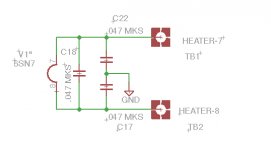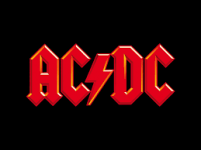The most sneaky one is where RF instability "detects" the heater AC and mashes it right into your signal. Many an unnecessary trip into DC heater land has resulted from simply not spotting the real problem and addressing it. Trouble is the amp will always sound **** even if it no longer hums.I have designed numerous valve mixers and amplifiers.
I almost always used AC heaters elevated to a DC value and had no problems.
Hum can get in many more ways than just heaters.
Shoog
i find dc heaters, dry, without emotions.....that is why i resist the temptations to use them...
There's a sticky thread which should give all the details you need ^^^.What are good rules of thumb and a basic schematic to implement AC heaters in line stages?
A DC reference to some fraction of the B+ is guaranteed to kill parasitic diode bleed of AC hum.
Shoog
Because, as I said, no electrode should be left floating. A floating electrode can pick up a huge voltage and then affect valve operation. If you are lucky, this won't happen but why risk it when the solution is so simple and harmless?gabdx said:I see all the books authors advocating a ref, why bother for small tubes?
i find dc heaters, dry, without emotions.....that is why i resist the temptations to use them...
I found that with DC, it makes a huge difference if you use a high impedance source. Also, using any caps to smooth right before the heater should be avoided at all cost....
Of course I am talking about DHT's here. with indirectly heated tubes/valves I use AC (except for phono).
Ian
Because, as I said, no electrode should be left floating. A floating electrode can pick up a huge voltage and then affect valve operation. If you are lucky, this won't happen but why risk it when the solution is so simple and harmless?
I will play the devils advocate , what if it sounds better? gives more free electrons to the cathode, idk.

what if it sounds better? gives more free electrons to the cathode, idk.

If you are lucky it won't sound any different. If it does sound different then it is overwhelmingly likely to have more distortion; some people may prefer this.gabdx said:I will play the devils advocate , what if it sounds better? gives more free electrons to the cathode, idk.
I am unclear whether you are just trying to be amusing, or trying to justify poor engineering.
There's a sticky thread which should give all the details you need ^^^.
A DC reference to some fraction of the B+ is guaranteed to kill parasitic diode bleed of AC hum.
Shoog
Doh! missed that one. Thanks!!
I'm doing a 6SN7 preamp layout right now. So far all the mock-ups have worked great with DC.
On the board Im thinking the filament should be bypass as shown. I have a bag of .047 600V MKS good for power filtering.
The preamp is designed specifically to operate on ultra cheap ebay switching supplies. A $1 bucking supply feeds heater.
Its hybrid CFP and uses Plus 24 and minus 24 VDC. The Plus 24 also feeds one TPA3116 d power amp. I listening to it right now.
The pre board is for a mono block.
So any opinions on bypassing, the goal is keeping switching noise down.
I don't hear any now but since probably one pass on the board fab I want to get it right.
pic attached
-bruce
On the board Im thinking the filament should be bypass as shown. I have a bag of .047 600V MKS good for power filtering.
The preamp is designed specifically to operate on ultra cheap ebay switching supplies. A $1 bucking supply feeds heater.
Its hybrid CFP and uses Plus 24 and minus 24 VDC. The Plus 24 also feeds one TPA3116 d power amp. I listening to it right now.
The pre board is for a mono block.
So any opinions on bypassing, the goal is keeping switching noise down.
I don't hear any now but since probably one pass on the board fab I want to get it right.
pic attached
-bruce
Attachments
With DHT like 10Y (or 801A), DC is a must with a good supply (chokes and caps or current regulators). However I don't know if DC heating worths the trouble with output tubes like KT88. Never had noise using AC in that case.
Guess I'll remove the caps and put power quality fix on a separate PS assy.
I planed on keeping the power supply/amp separate from preamp anyway.
For testing want to be able to use AC heater too.
Easy to use 12SN7 that way.
I planed on keeping the power supply/amp separate from preamp anyway.
For testing want to be able to use AC heater too.
Easy to use 12SN7 that way.
Last edited:
The caps will do nothing, apart from occupy space. If the heater supply is unusually noisy then you need a filter or a better PSU.
I am unclear what this means.jfetter said:I have a bag of .047 600V MKS good for power filtering.
The caps will do nothing, apart from occupy space. If the heater supply is unusually noisy then you need a filter or a better PSU.
I am unclear what this means.
I agree they are gone now.
Preamp board not a good place to clean up system power supply.
-
The caps will do nothing, apart from occupy space. If the heater supply is unusually noisy then you need a filter or a better PSU.
I am unclear what this means.
I only use WIMA MKP and MUSE BP in signal path.
The WIMA MKS 600v is good high quality for bypass cap, can take a lot of nasty.
-
This applies to DH types, and is related to the "disappearing cathode" phenomenon. The plate voltage, as seen from the cathode, isn't very high, five volts or so. The voltage differential along a DH cathode can go positive, during negative grid downswings, and low Ip. That part of the cathode simply "disappears", and alters the characteristic from a 1.5 law device to a 2.5 or even a 3.5 law characteristic with nastier harmonics that don't roll off with increasing frequency as fast.
I am very interested in the underpinnings of directly heated tube distortion differences relative to indirectly heated types. Can you cite any useful references on this topic?
I am very interested in the underpinnings of directly heated tube distortion differences relative to indirectly heated types. Can you cite any useful references on this topic?
There's this one from Steve Bench's site: Directly Heated Triodes operated with lower voltage on the filaments
- Status
- Not open for further replies.
- Home
- Amplifiers
- Tubes / Valves
- Tube heaters AC or DC?

